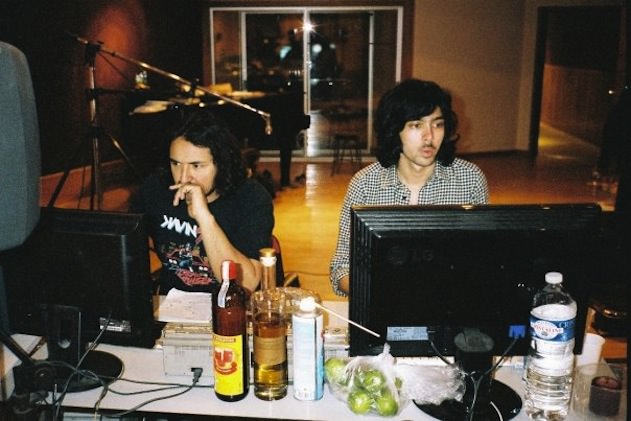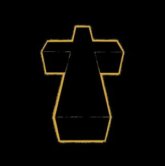
De Rosnay (right) at work in Philippe Zdar’s Motorbass studio, 2009
Micro-sampling
The labour-intensive recording process was necessitated by the fact that the bass, guitar and strings were not only sampled from other records, but also mostly note by note.
“In terms of sampling, our inspirations are divided into three categories,” de Rosnay explained. “The first is the one where we hear something on a record and think, ‘OK, that’s great. Let’s take a big part of it and just loop it.’ That’s what we did on ‘Phantom’, ‘Stress’ and ‘Newjack’.
“The second category contains songs we have been listening to all year or all our lives, and which we don’t actually sample. Instead, we ‘mentally sample’ them by adding bits that sound similar, and while we are sometimes aware of doing this, at other times we only realise it months or years later.
“The third category, representing about 90% of what we did on the first album, is ‘micro-sampling’.
“This applies to ‘D.A.N.C.E.’, which has no big sample – nothing that can be easily identified from another record. For example, the guitar is one note sampled from a record and used so that it works with the music. After we wrote the bass line, we also sampled every single note of the bass from other records and did the same with the strings. If a part needed F# played on a violin, we would find this on a record and insert it in the right place, and do this for every note that we needed on a violin or other stringed instrument.
“By using single notes from different records we created our own parts, and this was the main reason why the album was hard to make. Between the moment we write a song and the moment we finish it there are months of us finding all those small bits, sticking them in the right places and then deciding if they sound correct or need to be replaced with something else.
“In all, ‘D.A.N.C.E.’ took us four or five months to finish while we were working on other songs.”
Although micro-sampling meant that none of the source material is recognisable as used on ‘D.A.N.C.E.’, a few elements during the intro are a little easier to identify. These include a brief snatch of the outro from the Britney Spears/Madonna track ‘Me Against The Music’, as well as the sound of a radio being tuned, lifted from Bomb the Bass’s ‘On The Cut’, and the GarageBand sample ‘Radio Tuning 01’.
'D.A.N.C.E.' took us four or five months to finish while we were working on other songs.
Stick to the B.E.A.T.
 “‘D.A.N.C.E.’ was really hard to mix, and at first nobody liked it,” Xavier de Rosnay recalled. “Close friends were telling us we shouldn’t put it out, and that’s why we did a more electronic version [‘B.E.A.T.’] that ended up on the B-side of the single. Pedro Winter, the owner of Ed Banger Records, and So Me, our closest friend who works with us on graphic design, were essential in this regard because they were the only two people who told us, ‘No, the song is good. Let’s put it out as it is.’ Trusting their opinion, we agreed to release ‘D.A.N.C.E.'”
“‘D.A.N.C.E.’ was really hard to mix, and at first nobody liked it,” Xavier de Rosnay recalled. “Close friends were telling us we shouldn’t put it out, and that’s why we did a more electronic version [‘B.E.A.T.’] that ended up on the B-side of the single. Pedro Winter, the owner of Ed Banger Records, and So Me, our closest friend who works with us on graphic design, were essential in this regard because they were the only two people who told us, ‘No, the song is good. Let’s put it out as it is.’ Trusting their opinion, we agreed to release ‘D.A.N.C.E.'”
Even then, it was far from an immediate success. “When it was played in clubs it was a fiasco because, of course, it’s not a dance track,” de Rosnay continued, “and radio didn’t want to play it because of its sound and the thought that the kids were singing out of tune. So, it took some time, and I think the trigger for its success in France was its use in a commercial. After that, it was played on the radio and in 2007 it became the most broadcast track here.
“On the one hand, that was cool because it alerted people to the album, but on the other hand it was almost depressing because we realised it had far less to do with the music than with how well we were able to place it, making radio believe it’s a hit. That’s why we don’t even try to make radio-friendly music. It’s great if it turns out that way, but it’s much too hard to make music while thinking about that.”
In Classic Tracks, New York Times best-selling author Richard Buskin unearths the true stories behind 68 seminal recordings with songs by The Beatles, Bruce Springsteen, Bob Dylan, Nirvana, R.E.M., Oasis, Paul Simon, Phil Spector, John Lennon, The Police, Donna Summer, The Rolling Stones, David Bowie, Jimi Hendrix, Madonna, Metallica, The xx and many more.

04.11 AM
these guys make it look very easy, huh? genius duo
09.03 AM
Very very good article, Justice production techniques are one of the most questioned at production forums. I would love an in detail article about Cross tech production tips and some examples of how to achive that microsampling techniques. I think the secret of their famous distorted bass (ie phantom part 2) is about micro sample several types of bass and distort all of them combined.
That said, i would like a section on Attack Magazine where classic electronic albums where discussed, authors interviewed, etc. Future musice magazine has a section like this…
10.38 PM
@ Emma, yeah they do 😀
@ Tito, good idea i would love that too 🙂
12.49 PM
Thank you for this. A very good interview compared to all the others !
06.18 PM
it’s not gaspard augé on left ! FAIL
06.19 PM
(last picture)
11.21 AM
Excellent interview! Very interesting, thank you very much!
(It’s not Gaspard Augé on the studio with Xav, this was shot during the recording of Jamaica’s first album “No Problem”, I think it’s Peter Franco…)
11.38 AM
Apologies for the confusion with photo captions. Fixed now 🙂
12.13 PM
The First really interesting interview of Justice.
It’s fucking really hard to find article about the production tips of the band.
like Tito says.
Tito have you seen this?
http://www.musicradar.com/news/dj/interview-justice-511160
About DANCE too, but from Gaspard point of View!
I think the Microsampling is not really a difficult technique, it just take lot of time and lot of coffee in the choice, the cutting and the process of all the samples
I made this shitty track with my band few years ago, during the Justice-mania
it consisted in 100% of Micro-Sampling
https://soundcloud.com/r-e-s-p-i-r-e/decline
Check it out, just an example.
Tito Let me know if you have some interesting things about Production tips of Justice!
05.04 PM
I think the game has Tibackx bass guitar does everything…….. amazing score..
06.06 PM
Found an article on Justice’s samples for Cross and Audio, Video, Disco. Pretty interesting!
http://frenchshuffle.com/2015/06/28/songs-sampled-by-french-electro-duo-justice/